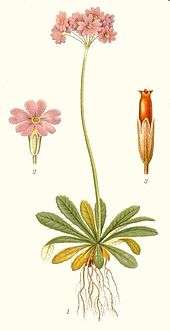Primula farinosa
Primula farinosa, the bird's-eye primrose, is a small perennial plant in the family Primulaceae, native to Northern Europe and northern Asia, and (rarely) farther south at high altitudes in the mountains of southern Europe. This primrose thrives on grazed meadows rich in lime and moisture.

Early 20th century illustration of bird's-eye primrose by botanist Carl Axel Magnus Lindman.
| Primula farinosa | |
|---|---|
 | |
| Scientific classification | |
| Kingdom: | Plantae |
| Clade: | Tracheophytes |
| Clade: | Angiosperms |
| Clade: | Eudicots |
| Clade: | Asterids |
| Order: | Ericales |
| Family: | Primulaceae |
| Genus: | Primula |
| Species: | P. farinosa |
| Binomial name | |
| Primula farinosa | |
 | |
| The range of Primula farinosa.[2] | |
Growth
This small, Arctic–alpine primrose grows from 3–20 centimetres (1.2–7.9 in) in height. The leaves are set in rosettes and are 2–10 centimetres (0.8–4 in) long and 1–2 centimetres (0.4–0.8 in) broad, smooth on top, powdery-white on the underside. The violet-blue flowers appear in early spring, and often in rounded clusters on top of a powdery stem when the plant is older.
gollark: >play apioforms rotate
gollark: >queue
gollark: >play https://radio-ic.osmarks.net/128k.ogg
gollark: >queue
gollark: >start
References
- Khela, S. (2012). "Primula farinosa". IUCN Red List of Threatened Species. 2012: e.T203398A2764887. Retrieved 30 January 2020.
- Guggisberg, A.; Mansion, G.; Conti, E. (2009). "Disentangling Reticulate Evolution in an Arctic-Alpine Polyploid Complex". Systematic Biology. 58 (1): 55–73. doi:10.1093/sysbio/syp010. PMID 20525568.
External links
- Majviva from guteinfo.com
This article is issued from Wikipedia. The text is licensed under Creative Commons - Attribution - Sharealike. Additional terms may apply for the media files.
